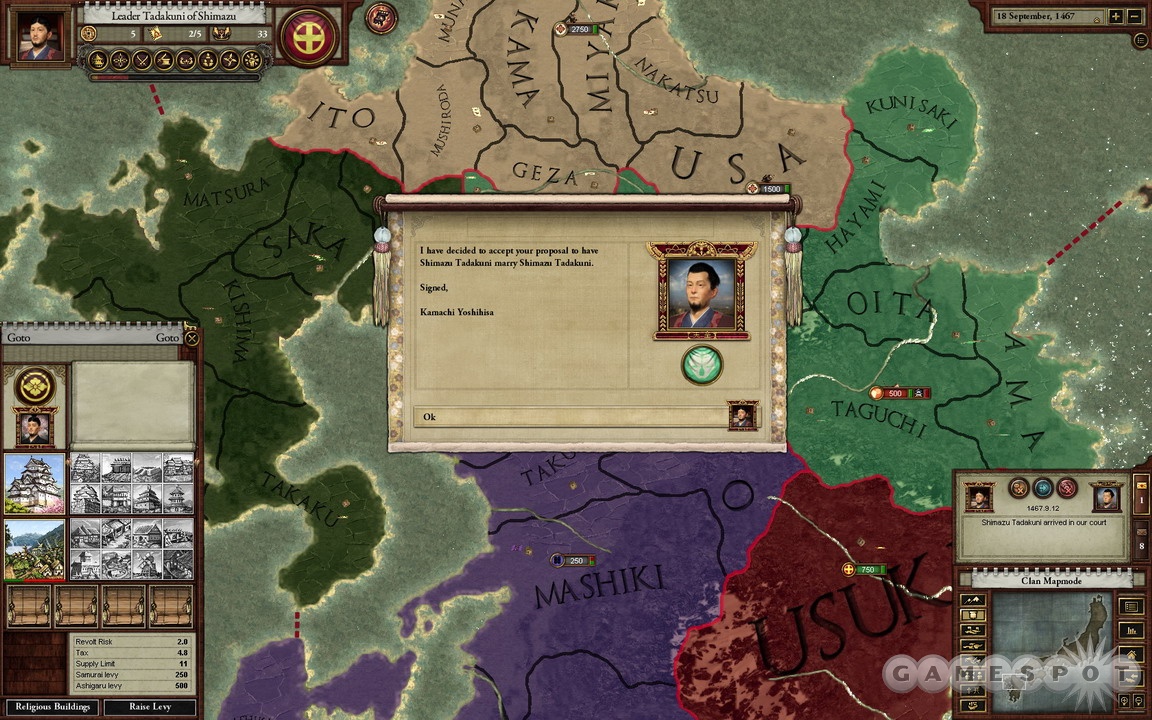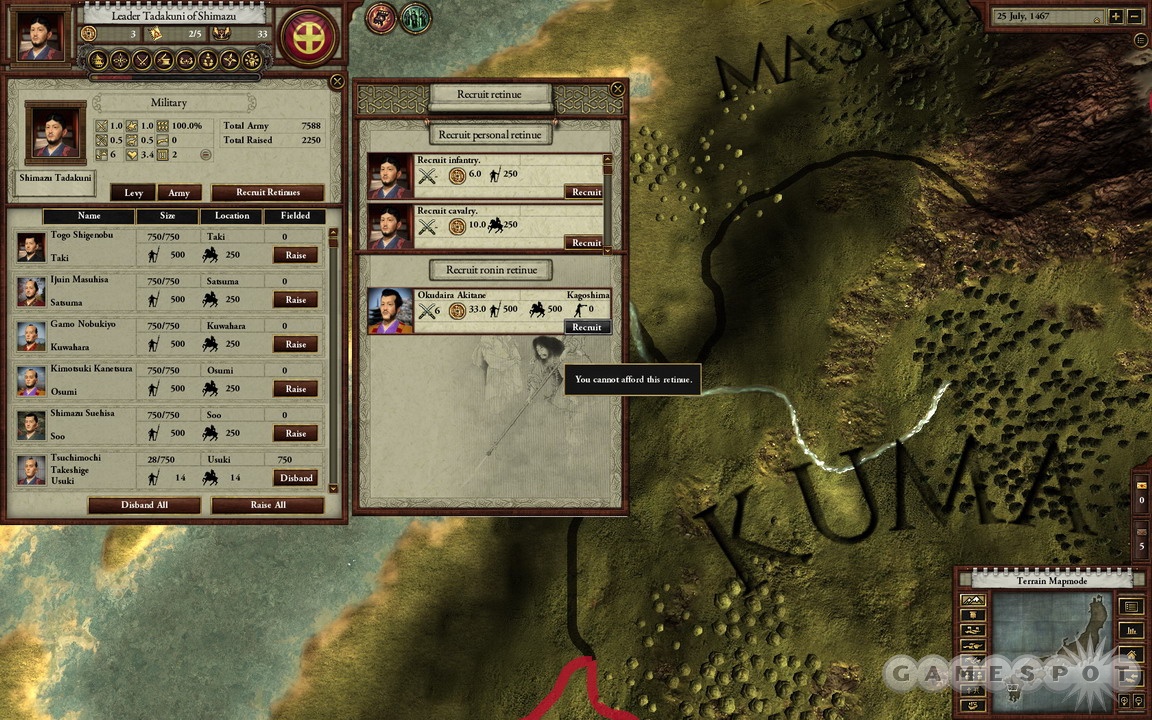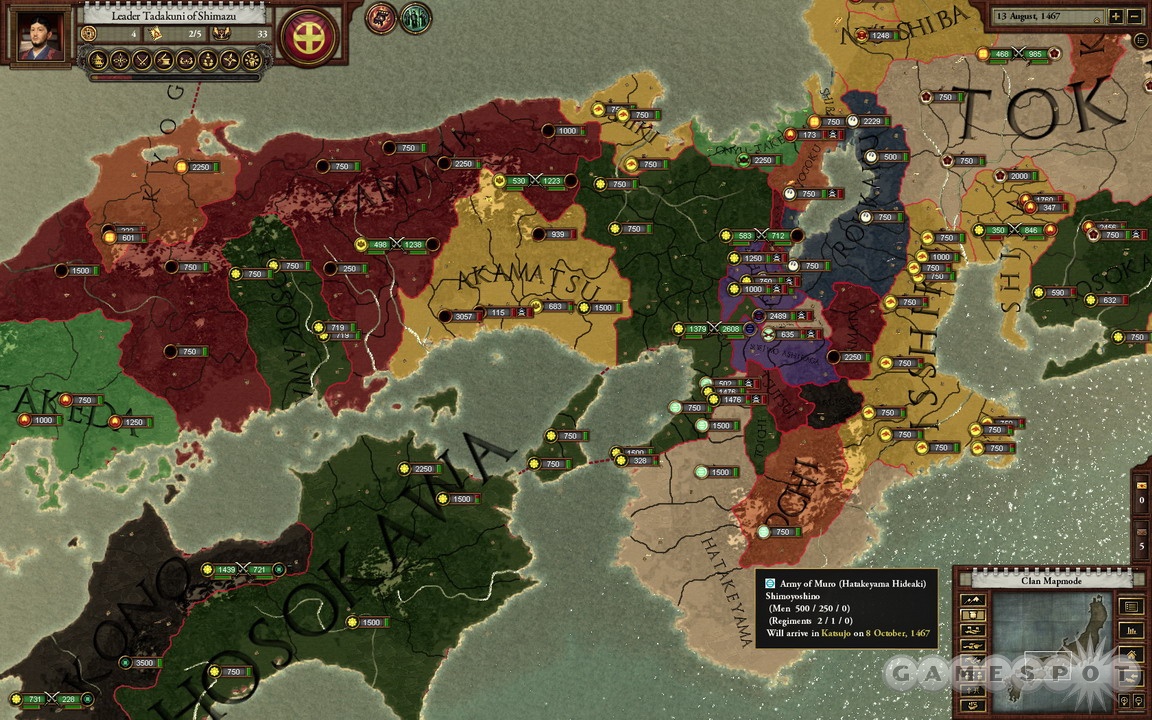Sengoku Hands-On Preview - First Three Years
We go hands-on for the first three years of our clan's history in the real-time strategy game Sengoku.
The 15th-century real-time strategy game Sengoku puts you in control of one of the many clans vying for the title of shogun in medieval Japan. True to form for publisher Paradox Interactive, this game features a complex management system used to control your clan's domestic and military affairs. During our first look at the game, we got the rundown on the many facets of this system and how they function. This time we got to go hands-on as the Shimazu clan and spend three long years attempting to guide our people toward greatness.

25 May, 1467: Following the game's advice, we started by opening the court view, assigning advisers, and putting them to work. The master of the guard, whose job included espionage and recruiting ninjas, was first since intrigue was our clan's strong suit. Chikahide won the seat thanks to the boost in intrigue provided by his paranoia trait (+2 intrigue, -1 diplomacy). Haruhide was a close second, but his unstable combination of the deceitful and lunatic traits made us think he would flip out and kill us before too long. The other two positions, master of arms and master of ceremonies, were then filled and we began work on improving our clan's provinces.
26 May, 1467: It quickly became apparent that we were not in complete control over all our clan's provinces. Out of our clan's sizable territory, we were in control of Ata and Kagoshima. The rest were managed by our clan's vassals. This way we didn't have to fiddle with each individual province and assign (and later update) construction orders. Instead, we were free to focus on more important matters.
3 July, 1467: Our neighbor to the north, the Kikuchi clan, was really getting on our nerves. To usurp the current shogun from his seat in Kyoto and assert ourselves as rulers over all Japan--and thereby win the game--we needed to control at least 56 percent of the map and hold it for 36 months. We could take land either by force or by diplomacy, folding lesser clans into our own. Hungry for action, we set our sights on the Kikuchi and deployed our master of the guard to Kuma province, one of their territories that sits on the border with our own. His mission was to sow dissent within the province and hopefully incite a revolt, or at least kick over a few trash cans.
28 August, 1467: The Otomo clan, which lies just north of Kikuchi territory, proposed that we strengthen the bond between our clans though marriage. Diplomatic relations, such as sending gifts or exchanging hostages, can help strengthen ties with your neighbors. In this case we happily agreed, though our groom-to-be ended up canceling the wedding, much to our dismay.

15 September, 1467: To crush the devious Kikuchi clan, we needed an army. Armies in Sengoku are composed of two groups of units: levies and retinues. Levies are trained in your clan's provinces, and their number and fighting strength are tied to the facilities available in that province. A province with a swordsmith, for example, would produce stronger units than one without. Retinues are your standing military and are tied to a specific character. They can be recruited by recruiting roaming ronin bands or by purchasing them. We started out by training some levies in two of our provinces, but we then decided to live a little and clicked the "Raise All" button to train levies in all our provinces.
15 October, 1467: Our excessive military spending put the clan's budget in the red. A bit embarrassed, we were forced to disband a few groups of levies to help even things out.
15 January, 1468: Kuma province, the one our master of the guard was stationed in, was developing its castle. Doing so would increase that province's defensive bonus as well as increase the number of levies that could be trained there. This was basically an act of war in our eyes, so we called back our adviser and pointed our young army toward Kuma.
11 July, 1468: As our forces marched into Kuma, we called up the Kikuchi to formally declare war. Doing so cost our clan some honor, which we could replenish by appeasing the current shogun though gifts or other favors. However, we had plenty of honor to go around and attacked the province. Even though Kuma had finished its castle, we expected it to fall swiftly before our might.
25 December, 1468: The siege of Kuma province took forever. In response to our declaration of war, the Kikuchi clan promptly began training some levies of its own to combat ours. However, the clan went all out, and by the time our forces captured Kuma, it had an army nearly twice the size of ours. Thankfully, we had some reinforcements en route to the front lines. Sengoku takes a hands-off approach to combat. When two sides start coming to blows, the action is displayed in a small window detailing the fighting strength of each side. It's then updated in real time as the battle plays out, and if your side is taking a beating, you can always order your men to retreat. Otherwise, it's all up to them.
8 May, 1469: As the battle for Kikuchi's land raged on, we took a moment to pause the action and check in on our main provinces. In Ata, our master of ceremonies had finished upgrading our town to the second tier, thus improving its income rate. We had also set our master of the guard to work expanding the guild presence in Kagoshima, which opened one of the four special structure slots in that province. Unfortunately, all the fancy buildings we could build there were out of our price range thanks to the upkeep costs of all our troops.

16 April, 1470: Our time with the Shimazu clan came to a close with battles raging across Kikuchi territory. Had we been a little more patient in our approach, we might have been able to convince the Otomo clan to form a plot with us to attack the Kikuchi. Plots are objectives generated by the game for your clan to work toward. Each plot has a plot power that reflects the strength of the target compared with you and your plot backers. Once you reach a certain amount of plot power, you can execute the plot. Or you can do what we did and just charge in with swords out. Whatever your tactic, you can put it to the test when Sengoku is released on the PC later this year.
Got a news tip or want to contact us directly? Email news@gamespot.com
Join the conversation